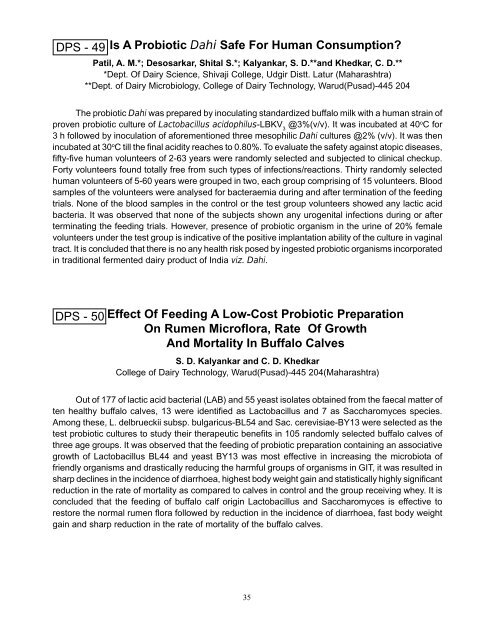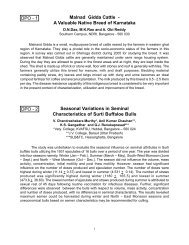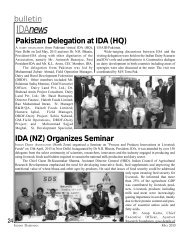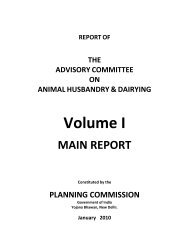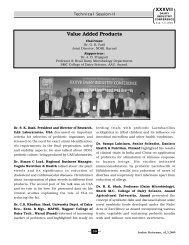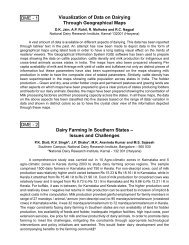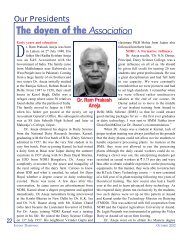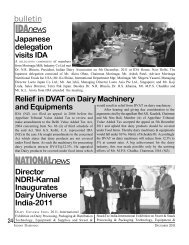Prevalence of Antibiotic Resistance in Dairy Strains of Streptococcus ...
Prevalence of Antibiotic Resistance in Dairy Strains of Streptococcus ...
Prevalence of Antibiotic Resistance in Dairy Strains of Streptococcus ...
You also want an ePaper? Increase the reach of your titles
YUMPU automatically turns print PDFs into web optimized ePapers that Google loves.
DPS - 49Is A Probiotic Dahi Safe For Human Consumption?Patil, A. M.*; Desosarkar, Shital S.*; Kalyankar, S. D.**and Khedkar, C. D.***Dept. Of <strong>Dairy</strong> Science, Shivaji College, Udgir Distt. Latur (Maharashtra)**Dept. <strong>of</strong> <strong>Dairy</strong> Microbiology, College <strong>of</strong> <strong>Dairy</strong> Technology, Warud(Pusad)-445 204The probiotic Dahi was prepared by <strong>in</strong>oculat<strong>in</strong>g standardized buffalo milk with a human stra<strong>in</strong> <strong>of</strong>proven probiotic culture <strong>of</strong> Lactobacillus acidophilus-LBKV 3@3%(v/v). It was <strong>in</strong>cubated at 40 o C for3 h followed by <strong>in</strong>oculation <strong>of</strong> aforementioned three mesophilic Dahi cultures @2% (v/v). It was then<strong>in</strong>cubated at 30 o C till the f<strong>in</strong>al acidity reaches to 0.80%. To evaluate the safety aga<strong>in</strong>st atopic diseases,fifty-five human volunteers <strong>of</strong> 2-63 years were randomly selected and subjected to cl<strong>in</strong>ical checkup.Forty volunteers found totally free from such types <strong>of</strong> <strong>in</strong>fections/reactions. Thirty randomly selectedhuman volunteers <strong>of</strong> 5-60 years were grouped <strong>in</strong> two, each group compris<strong>in</strong>g <strong>of</strong> 15 volunteers. Bloodsamples <strong>of</strong> the volunteers were analysed for bacteraemia dur<strong>in</strong>g and after term<strong>in</strong>ation <strong>of</strong> the feed<strong>in</strong>gtrials. None <strong>of</strong> the blood samples <strong>in</strong> the control or the test group volunteers showed any lactic acidbacteria. It was observed that none <strong>of</strong> the subjects shown any urogenital <strong>in</strong>fections dur<strong>in</strong>g or afterterm<strong>in</strong>at<strong>in</strong>g the feed<strong>in</strong>g trials. However, presence <strong>of</strong> probiotic organism <strong>in</strong> the ur<strong>in</strong>e <strong>of</strong> 20% femalevolunteers under the test group is <strong>in</strong>dicative <strong>of</strong> the positive implantation ability <strong>of</strong> the culture <strong>in</strong> vag<strong>in</strong>altract. It is concluded that there is no any health risk posed by <strong>in</strong>gested probiotic organisms <strong>in</strong>corporated<strong>in</strong> traditional fermented dairy product <strong>of</strong> India viz. Dahi.DPS - 50Effect Of Feed<strong>in</strong>g A Low-Cost Probiotic PreparationOn Rumen Micr<strong>of</strong>lora, Rate Of GrowthAnd Mortality In Buffalo CalvesS. D. Kalyankar and C. D. KhedkarCollege <strong>of</strong> <strong>Dairy</strong> Technology, Warud(Pusad)-445 204(Maharashtra)Out <strong>of</strong> 177 <strong>of</strong> lactic acid bacterial (LAB) and 55 yeast isolates obta<strong>in</strong>ed from the faecal matter <strong>of</strong>ten healthy buffalo calves, 13 were identified as Lactobacillus and 7 as Saccharomyces species.Among these, L. delbrueckii subsp. bulgaricus-BL54 and Sac. cerevisiae-BY13 were selected as thetest probiotic cultures to study their therapeutic benefits <strong>in</strong> 105 randomly selected buffalo calves <strong>of</strong>three age groups. It was observed that the feed<strong>in</strong>g <strong>of</strong> probiotic preparation conta<strong>in</strong><strong>in</strong>g an associativegrowth <strong>of</strong> Lactobacillus BL44 and yeast BY13 was most effective <strong>in</strong> <strong>in</strong>creas<strong>in</strong>g the microbiota <strong>of</strong>friendly organisms and drastically reduc<strong>in</strong>g the harmful groups <strong>of</strong> organisms <strong>in</strong> GIT, it was resulted <strong>in</strong>sharp decl<strong>in</strong>es <strong>in</strong> the <strong>in</strong>cidence <strong>of</strong> diarrhoea, highest body weight ga<strong>in</strong> and statistically highly significantreduction <strong>in</strong> the rate <strong>of</strong> mortality as compared to calves <strong>in</strong> control and the group receiv<strong>in</strong>g whey. It isconcluded that the feed<strong>in</strong>g <strong>of</strong> buffalo calf orig<strong>in</strong> Lactobacillus and Saccharomyces is effective torestore the normal rumen flora followed by reduction <strong>in</strong> the <strong>in</strong>cidence <strong>of</strong> diarrhoea, fast body weightga<strong>in</strong> and sharp reduction <strong>in</strong> the rate <strong>of</strong> mortality <strong>of</strong> the buffalo calves.35


